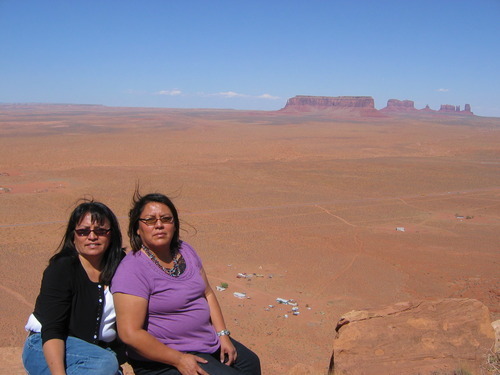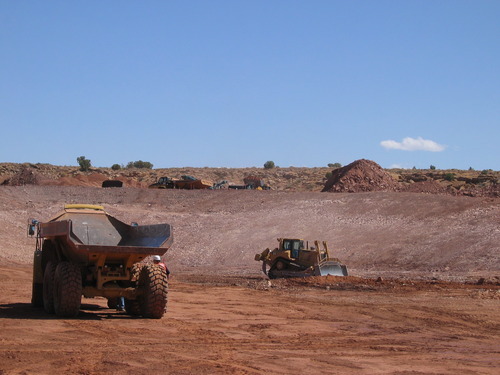This is an archived article that was published on sltrib.com in 2011, and information in the article may be outdated. It is provided only for personal research purposes and may not be reprinted.
MONUMENT VALLEY - The long days of squealing gears and grumbling motors don't bother Elsie Mae Begay.
Although the racket on the mesa above her home wrecks the quiet of this mystical landscape, it also seems to bring the Navajo matriarch peace."I hear the trucks," she says, smiling broadly. "When they start cleaning up, it's OK for us."The cacophony is proof Begay's pleas for help over more than a decade have been heard by the powers that be. Up on top of Oljato Mesa, the U.S. Environmental Protection Agency is preparing to remove the poisonous uranium-mining rubbish that has haunted thefamily for decades.Down to business
The work began in earnest this spring.
"I've got to make this hazard go away as soon as possible," says Jason Musante, EPA's on-scene coordinator for the $6 million cleanup. "It's already been too long."The task is not an easy one. The agency, undertaking the "emergency cleanup" as an interim solution until the Navajo Nation decides on a permanent one, has a half-century of local distrust to deal with along with the practical challenges of eliminating the uranium hazard.Musante's work here is part of EPA's plan to address uranium problems all over the reservation. About $22 million is dedicated to building alternative water systems. Another $60 million over five years will go toward identifying and dealing with contaminated homes and mine sites.Crews already have carved a bowl from the rock on top of Oljato Mesa about a football field's length from the caves - now closed off with cinder blocks - that miners once used to get at the uranium ore. Designed like the special landfills for corrosive hazardous waste, the bowl will have top and bottom liners of super-strong plastic to create what Musante calls "giant Tupperware in the ground."Most of the tainted dirt that will be sealed in the cell - around 30,000 cubic yards - will come from two areas on the valley bottom 800 feet below the mesa top. Both areas are just beyond a jumble of dwellings built on land that Begay's aunt, Mary Holiday, settled around the time mine operations ended in 1962.One high-radiation heap lies at the mesa's foot. Identified by a long gray streak below the old mine entrances, the rubble pile marks the spot where steel cable once lowered buckets of uranium ore to the valley floor.The second big hot spot is a pile where miners loaded ore from mine cars onto haul trucks. Roughly halfway between the first pile and the trailer where Begay lives, this area has the highest concentrations of radium-226, a decay product of uranium that releases large amounts of cancer-causing radon.Overall, EPA investigators found 80 spots on the three-acre site where penetrating gamma radiation measured at least twice the level of natural background radiation.Musante plans to hoist it up the mesa side and bury it in the cell."We're going to take it up," Musante said of the piles of tainted dirt. "We're going to wipe the table before we sweep the floor."The history
Begay grew up in Monument Valley before uranium mining began. As friends of trading post founder Harry Goulding, she and her family became the face of "every Indian" in Monument Valley films, postcards and guidebooks. Their redrock backyard served as a scenic backdrop for Westerns.
Then companies began digging more than 1,000 mines on the Navajo Reservation. They eventually produced more than 4 million tons of uranium and vanadium ore for atomic weapons and, later, for nuclear power plant fuel, and a generation of uranium families.The sister of a uranium miner, Begay also married one. And, when their marriage ended in 1978, she asked to live on her aunt's land below Skyline.She started to worry that something was wrong when the roster of dead and ill family members started growing. One of her sons, Lewis, died from a brain tumor at age 24. Another, Leonard, died of lung cancer at 42, though he never smoked or worked in the mines.Begay's story is chronicled in "The Return of the Navajo Boy," an independent film produced in 2000, a few years after EPA began probing the radiation risk on the reservation.Back then, the agency found radiation hot spots all over the Navajo Nation, an expanse roughly the size of West Virginia in Utah, New Mexico and Arizona.Twenty-nine water sources had worrisome radiation levels. So did one of the traditional eight-sided homes in Begay's settlement that had been used by Begay, now 72, her aunt and their families for nearly a half-century.Penetrating gamma radiation inside the "hogan" was 80 times higher than EPA limits for human exposure. And, in 2001, an EPA emergency crew wearing protective suits and respirators razed it.With the contaminated hogan and piles gone, it might seem as though the trouble below Skyline is passed. But a cloud of concern endures.A legacy of distrust
Mustante has discovered that being an on-scene coordinator also means being an on-site counselor. He is left to grapple with endless questions and uneasiness that has become deep rooted in this community.
In April, he met with leaders at the Oljato Chapter to tell about the cleanup and to begin addressing community concerns. Then, earlier this month, Musante spent the afternoon with Elsie's daughter-in-law, Mary Helen Begay, and her sister, Helen Myerson, whose home can be seen from the cleanup site."I'm glad it's happening," said Myerson, a grandmother of four. "I'm glad at least they're doing something."Still, she wonders if the cell on the mesa might contaminate the water. She worries the runoff might carry tainted soil to her sister's house across the road. She questions whether the cleanup site will ever be a safe place for children to play, or if people should be moved to new locations."You would want your child to be away from it," Myerson told Musante. "You wouldn't want them to have any health issues."Noting that the site will have less than half the radioactivity Musante can measure at his own home in Los Angeles, he says EPA is determined to protect people from the immediate hazard. The Navajo Nation sees the Skyline uranium cell as an interim solution, he explains, and someday tribal leaders hope to move the pile off the reservation."The difficulty," says Musante, "is you can never go back to what it was before."Elsie Mae Begay has no trouble with that. She'll move back after the temporary relocation during the cleanup of the valley floor.But Mary Helen Begay, who has been keeping a video chronicle of the work, questions the area's long-term safety. She's hoping EPA will follow through on her suggestion that children should be taught about the impacts of uranium mining as part of their school science curriculum on the reservation.Navajo children, she said, "have no background in that."fahys@sltrib.com-The project's logisticsThe $6 million cleanup focusing on three acres is anything but easy. EPA crews had to rebuild the mine road that twists tightly up the back of the Oljato Mesa to get heavy equipment on top. Yet it remains too steep and narrow for turning, so vehicles must drive backward for part of the ride up or down.EPA contractors installed large tanks to store the water used for keeping dust down on the roads. They also built a borrow pit to supply clean dirt and rocks for the containment cell that will hold the contaminated material.A particularly tricky area to clean up will be the gray piles of uranium ore that settled on the ridges just over the top edge of Oljato Mesa. The EPA plans to scrape the 1- to 2-foot deep piles of tainted dirt upward along the mesa wall. —
The project's logistics
The $6 million cleanup focusing on three acres is anything but easy. EPA crews had to rebuild the mine road that twists tightly up the back of the Oljato Mesa to get heavy equipment on top. Yet it remains too steep and narrow for turning, so vehicles must drive backward for part of the ride up or down.
EPA contractors installed large tanks to store the water used for keeping dust down on the roads. They also built a borrow pit to supply clean dirt and rocks for the containment cell that will hold the contaminated material.
A particularly tricky area to clean up will be the gray piles of uranium ore that settled on the ridges just over the top edge of Oljato Mesa. The EPA plans to scrape the 1- to 2-foot deep piles of tainted dirt upward along the mesa wall.

















